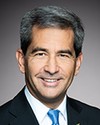Our search and rescue technicians are still prepared to do that if they need .to They'll do what they need to do to get the job done. They are an incredible class of Canadians, and I've watched them on video jumping into locations where the average service personnel would say that takes a special brand of courage.
For our SAR posture, we keep and analyze statistics. We use operational research on an ongoing basis to ensure that we have the optimum posture going forward. But it's a complex environment. Only 4% of search and rescue incidents occur north of the 55th parallel, so if you draw a line among the northern provinces in the west toward Fort McMurray and just a little bit north, and draw it along and cover off northern Quebec and a little part of northern Ontario, only 4% occur beyond that. However, every one of them is complex just by virtue of the environment.
We have a SAR posture across the country that is optimized toward where the majority of incidents will occur, but with a capacity to surge forward, depending on the scenario and the circumstances, in response to a crisis in the north.
The reality of our geography in Canada is that most of the people live in the south, which means that even routine miliary operations are almost expeditionary in nature in our own country. We project over long distances. To fly from Winnipeg to the high north is like flying from St. John's, Newfoundland, across the Atlantic.
We are mindful of that in everything that we orient toward the posture, but we have a whole range of assets. The way that we work, even beyond the immediate response search and rescue posture, which I know you've been briefed on.... At least, I believe Admiral Ellis was here. No, excuse me, he was at the Senate. My apologies.
It's a subject that is worth a deep dive on its own. We can get from Winnipeg with a primary Hercules in four to eight hours depending on where the incident is in the Arctic; with a Cormorant in about 12 to 16 hours depending on where it's at; and we can work through some of our hubs in the north to extend assets over range. Working off of Baffin Island, we had many of the assets touch down in Iqaluit, refuel there, and then carry on to station.
It's a complex posture and a lot depends on the circumstances, the nature of the incident and what we have to throw at it.




